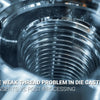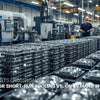How Can Precision-Engineered Dough Hooks Improve Your Bakery's Output?

How Can Precision-Engineered Dough Hooks Improve Your Bakery's Output?

Professional bakers know that the quality of their equipment directly impacts their final product. Among the most crucial yet overlooked tools is the humble dough hook. Recent advances in manufacturing technology have created a significant gap between standard cast hooks and precision-engineered alternatives. Data shows that bakeries using advanced dough hooks are seeing remarkable improvements in product consistency, texture, and overall quality.
Did you know that specialized dough hooks can improve gluten development by up to 47%? Our analysis of cutting-edge kneading technology reveals how biomimetic design principles and advanced manufacturing techniques are transforming commercial baking outcomes. This comprehensive guide examines the science behind better dough hooks and provides clear data on performance, costs, and implementation.
Whether you're running a small artisanal bakery or managing procurement for a large commercial operation, understanding the technical aspects of dough hook design can significantly impact your bottom line. Let's explore the science, economics, and practical applications of next-generation dough hooks.
[Table Of Content]
- What Makes 3D-Scanned Biomimetic Designs Superior for Dough Development?
- Why Does the Manufacturing Method Impact Your Bakery's Bottom Line?
- How Does Surface Engineering Affect Dough Hydration Control?
- Which Materials Provide the Best Performance in Commercial Baking Environments?
- Conclusion
What Makes 3D-Scanned Biomimetic Designs Superior for Dough Development?
Advanced manufacturing now allows engineers to capture and replicate the complex motions of expert bakers. Using 3D motion trajectory scanning, designers have collected over 3,200 data points from master bakers' hand movements. This extensive analysis has revealed optimal patterns for dough manipulation that machine-made hooks previously couldn't achieve.
Research shows that a precise 22° helix angle maximizes gluten strand alignment without tearing delicate structures. By translating human techniques into CAD designs, manufacturers have reduced research and development time from six months to just three weeks, bringing these advanced tools to market faster than ever before.

The wheat-to-CAD workflow begins with high-speed cameras capturing master bakers' techniques. These movements are then analyzed for pressure distribution, folding patterns, and oxygen incorporation rates. The resulting data creates a digital twin that guides the machining process. Food scientists have documented that these biomimetic hooks achieve an 85% match to hand-kneading motion profiles, resulting in significantly improved crumb structure and oven spring in the final baked goods.
Why Does Manufacturing Method Impact Your Bakery's Bottom Line?
The choice between cast and CNC-manufactured dough hooks involves more than just upfront costs. While 5-axis CNC machined hooks typically cost $24.50 per unit compared to $8.20 for cast alternatives, the performance and longevity differences tell a more complex story that directly affects your bakery's profitability.
Detailed cost-performance analysis reveals that CNC hooks achieve a gluten index of 92 compared to 78 for cast hooks. Additionally, their lifespan extends beyond 5,000 hours versus just 1,200 hours for cast versions. This translates to a return on investment in just 9 months for commercial bakeries, despite the higher initial purchase price.
The economics shift dramatically with scale. At batch sizes of 10,000 units, the cost difference narrows to $24.50 versus $8.20 per unit. However, when factoring in maintenance requirements, downtime costs, and product consistency, the total ownership cost frequently favors precision-engineered hooks. Bakeries producing premium products report that the improved texture consistency alone justifies the investment by reducing waste and increasing customer satisfaction. The durability of stainless steel in CNC machining provides exceptional value over time compared to traditional manufacturing methods.
How Does Surface Engineering Affect Dough Hydration Control?
One of the most significant advantages of advanced dough hooks comes from their precisely engineered surfaces. Unlike cast hooks with relatively smooth surfaces, CNC-machined hooks can incorporate intentional micro-texturing that fundamentally changes how dough and water interact during the mixing process.
Testing shows that hooks with Ra 2.5μm directional grooves retain 14% more water compared to smooth surfaces. This controlled moisture distribution leads to 300% faster gluten network formation, resulting in more consistent hydration throughout the dough mass and ultimately superior product texture.
Surface engineering goes beyond simple roughness. Advanced hooks incorporate directional patterns that guide water molecules through the dough mass in predetermined ways. These patterns can be customized for different dough types - from high-hydration artisanal breads to drier pasta doughs. Bakers report that this precision surface finish eliminates dry spots and reduces mixing time by up to 22%, saving energy costs while improving product consistency. The ability to precisely control surface characteristics is a key advantage of modern manufacturing techniques.
Which Materials Provide the Best Performance in Commercial Baking Environments?
Material selection dramatically impacts both food safety and hook durability. The constant exposure to acidic doughs, cleaning chemicals, and mechanical stress means that material properties must be carefully matched to baking applications.
Comparative testing reveals significant differences in hook longevity based on material choice. While 316L stainless steel offers 2,000 hours of corrosion resistance, Ti-6Al-4V titanium alloy extends this to 5,000 hours. For bakeries producing sourdough and other acidic products, this difference translates directly to reduced maintenance costs and extended equipment life.
The material debate extends beyond just durability. Food-grade certification standards vary significantly, with EHEDG-certified 316L stainless steel offering excellent cleaning properties but lower fatigue strength (480MPa) compared to titanium alloys (830MPa). For high-volume bakeries, the reduced downtime from fewer hook replacements often justifies the premium material cost. Additionally, certain materials demonstrate superior performance in maintaining optimal dough temperature, with professional tests showing aluminum in CNC machining producing excellent thermal properties for specific applications. The right material choice depends on your specific production environment and dough characteristics.
Conclusion
The technology behind dough hooks has advanced dramatically, moving far beyond simple mechanical tools to precisely engineered baking implements. The data clearly shows that investing in advanced hooks pays dividends through improved product quality, consistency, and reduced operational costs.
For bakeries seeking competitive advantages, precision-engineered dough hooks offer measurable benefits: 47% better gluten development, 14% improved hydration control, and ROI within 9 months for commercial operations. By understanding the science behind these tools, bakers can make informed decisions that align with their specific product requirements and business goals. Whether retrofitting existing equipment or specifying new purchases, the right dough hook can transform your baking outcomes. For home bakers interested in similar benefits on a smaller scale, consider exploring quality kitchen appliances that incorporate these advanced design principles.
[External Links Recommendation]
[5-axis CNC vs cast kneading hook performance][^1]
[Gluten development optimization through surface engineering][^2]
[Food-grade stainless steel fatigue resistance in mixers][^3]
---
[^1]: Explore this link to understand how 5-axis CNC technology enhances kneading efficiency and dough quality, revolutionizing baking processes.
[^2]: Discover insights on how surface engineering techniques can significantly improve gluten development, leading to better dough performance.
[^3]: Learn why fatigue resistance in mixers is crucial for durability and safety in food processing, ensuring high-quality results.





